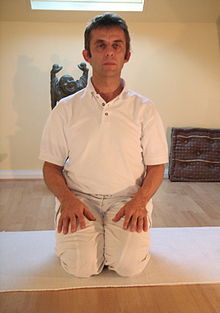Vajrasana (yoga)
The 15th century Hatha Yoga Pradipika called it a synonym of Siddhasana, where one of the heels presses the root of the repoductive organ; according to Yoga-Mimamsa III.2 p. 135, this explains the reference to the vajra weapon.[4] The 17th century Gheranda Samhita 2.12 describes what Light on Yoga calls Virasana, with the feet beside the buttocks, while in other texts Vajrasana appears to mean the modern kneeling-down position, with the buttocks resting on the feet.There is a four finger gap between the kneecaps, and the first toe of both the feet touch each other and sit erect.The reclining form of the pose, used in Ashtanga Vinyasa Yoga,[6] is Supta Vajrasana.[7] Laghuvajrasana, an advanced pose in Ashtanga Vinyasa Yoga and Iyengar Yoga, has the thighs raised halfway from the sitting position, the crown of the head on the floor and the hands grasping the ankles.
Bodh GayaDiamond throneSanskritromanizedhatha yogayoga as exercisemeditationHatha Yoga PradipikaSiddhasanaGheranda SamhitaLight on YogaVirasanaNorman SjomanAshtanga Vinyasa YogaIyengar Yogaorthopaedic surgeonscommon fibular nervefoot dropdorsiflexionList of asanasYoga JournalSjoman, Norman E.Iyengar, B. K. S.Light on Yoga: Yoga DipikaThe Washington PostTelegraphJournal of the American Medical AssociationBroad, William J.The New York TimesAsanasDrishtiPranayamaSun SalutationVinyasaYoga as therapyAnjaneyasana (crescent moon)Bidalasana (cat)/Bitilasana (cow)Bhujangasana (cobra)Chakrasana (wheel) or Urdhva Dhanurasana (upward bow)Viparita Dandasana (inverted staff)Kapotasana (pigeon)Eka Pada Rajakapotasana (king pigeon)Ushtrasana (camel)Ashtavakrasana (8-angled)Bakasana (crane) or Kakasana (crow)Koundinyasana (the sage Kaundinya)Kukkutasana (cockerel)Mayurasana (peacock)Tittibhasana (firefly)Adho Mukha Svanasana (downward dog)Adho Mukha Vrkshasana (handstand)Halasana (plough)Sarvangasana (shoulderstand)Setu Bandha Sarvangasana (bridge)Shirshasana (headstand)Viparita Karani (legs up the wall)Vrischikasana (scorpion)Anantasana (Vishnu's couch)Ashtanga Namaskara (eight-limbed)Bhekasana (frog)Chaturanga Dandasana (low plank)Dhanurasana (bow)Jathara Parivartanasana (belly twist)Makarasana (crocodile)Matsyasana (fish)Shalabhasana (locust)Shavasana (corpse)Vasishtasana (side plank)Yoganidrasana (yogic sleep)Baddha Konasana (cobbler)Gomukhasana (cow face)Gorakshasana (cowherd)Padmasana (lotus)Siddhasana (accomplished)Simhasana (lion)Bharadvajasana (the sage Bharadvaja)Marichyasana (the sage Marichi)Matsyendrasana (the sage Matsyendra, lord of the fishes)Pashasana (noose)Akarna Dhanurasana (shooting bow)Balasana (child)Garbha Pindasana (embryo in womb)Hanumanasana (monkey)Kraunchasana (heron)Kurmasana (tortoise)Malasana (garland)Mandukasana (frog)Mulabandhasana (root lock)Navasana (boat)Paschimottanasana (seated forward bend)Samakonasana (split)Virasana (hero)StandingParighasana (gate)Parshvottanasana (intense side stretch)Prasarita Padottanasana (wide stance forward bend)Tadasana (mountain)Trikonasana (triangle)Utkatasana (powerful)Uttanasana (standing forward bend)Utthita Parshvakonasana (sideways)Virabhadrasana (warrior)Ardha Chandrasana (half moon)Durvasasana (the sage Durvasa)Garudasana (eagle)Natarajasana (lord of the dance)Utthita Padangusthasana (standing big toe hold)Vrikshasana (tree)Standing asanasDownward dogLotus positionMeditation seatsTree poseWarriorNamasteVinyāsaHasta VinyasasTeacher trainingBritish Wheel of YogaEuropean Union of YogaAndré Van LysebethYoga AllianceTherapyYoga using propsAccessible yogaTrauma-sensitive yoga


